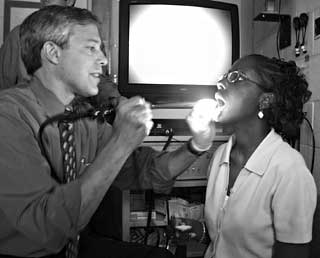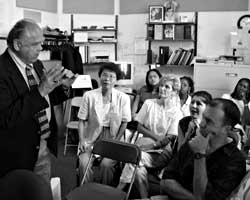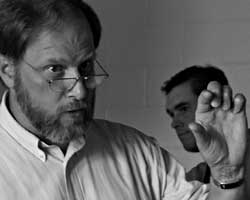Art Meets
Science in
Professional Voice Care:
OBSVAC & The Cleveland Clinic Foundation
by Michael Chipman AD '00
 Any
OBSVAC tour offers an intimidating array of equipment, fast facts
for curious minds, and practical applications for singers and wind
instrument musicians. There's usually lots of laughter at the Center,
an abundance of oohs and aahs, and then things get real quiet...
Any
OBSVAC tour offers an intimidating array of equipment, fast facts
for curious minds, and practical applications for singers and wind
instrument musicians. There's usually lots of laughter at the Center,
an abundance of oohs and aahs, and then things get real quiet...
Since its inception in December 1989, Oberlin Conservatory's Otto B. Schoepfle Vocal Arts Center (OBSVAC) has been devoted to the advancement of voice pedagogy and excellence in performance. Hundreds of singers as diverse as Conservatory freshman and Metropolitan Opera artists have reaped the benefits of OBSVAC's facilities that apply graphic, measured analyses to artistic singing. In addition, numerous faculty from national and international conservatories and schools of music visit the laboratory.
OBSVAC's mission is two-fold: to disseminate information for the enhancement of voice pedagogy at large; and to examine, via scientific analyses, subjective pedagogic concepts. OBSVAC doesn't seek new techniques for the teaching of singing; rather, it examines the ways in which conflicting ideas of voice pedagogy relate to efficiency and functional freedom in the production of sung sound.
Through immediate real-time audio/visual feedback, a singer may observe on video monitors such vocal events as onset and release, vowel definition vowel modification, agility, registration, intensity, nasality, degrees of legato, phrase shaping and vibrato rates. Most importantly, the singer is alerted to the spectral relationships among overtones and formants that characterize the professional singing voice. Videos of lessons and performances can be readily analyzed. Analyses of videotapes and performance films by great artists provide further powerful study tools.
While Richard Miller's vision and perseverance must receive credit for the creation and success of OBSVAC, the center director is quick to praise the OBSVAC affiliate scholars for its continued growth and excellence. These include Douglas Hicks (director of the Voice Center and head of speech-language pathology), and Dr. Tom Abelson OC '72 (otolaryngologist in head and neck surgery/ assistant clinical professor of otolaryngology at Case Western Reserve University School of Medicine), both of The Cleveland Clinic Foundation; Paul Oncley, now retired from a rich career that included work as a instrumental and vocal musician, professor of voice, military acoustician, and research scientist at Bell Telephone Laboratories; Ronald C. Scherer, associate professor at Bowling Green State University's Department of Communication Disorders in the College of Health and Human Services; and Peter Watson, assistant professor at Case Western Reserve University's Department of Communication Sciences.
Through these relationships with top professionals and world-renowned medical institutions like The Cleveland Clinic, Miller continues to nurture his career-long efforts to fuse the scientific and artistic aspects of vocal pedagogy. Additionally, Miller is an adjunct staff member at the Cleveland Clinic Foundation.
Lorraine Manz, associate professor of voice and associate director of OBSVAC, says she and the voice faculty at Oberlin are "grateful for the ongoing association with the affiliate scholars. These professionals are dedicated to the mission of educating the professional voice user, providing us with clear and accurate information. They help us to better understand what it is to use the voice at its most efficient level of function, reducing the possibility that our students develop habits that might cause unnecessary fatigue or harm. We are always inspired by their presentations and the exciting dialogue that follows. A frequent question heard around here is, 'When are they coming back?'"
 Miller
first met Douglas Hicks in the late 1970s at the Juilliard (now
the Voice Foundation) Symposium. "I saw Doug had great interest
in the voice," says Miller. "We met yearly after that. He was
involved in the study of vibrato rate, and had worked with experts
in that area. When I needed to set up the voice equipment for
OBSVAC, he and Ron Scherer provided valuable suggestions and help.
Now they and Tom Abelson come every semester to perform fiberscopic
examinations for students."
Miller
first met Douglas Hicks in the late 1970s at the Juilliard (now
the Voice Foundation) Symposium. "I saw Doug had great interest
in the voice," says Miller. "We met yearly after that. He was
involved in the study of vibrato rate, and had worked with experts
in that area. When I needed to set up the voice equipment for
OBSVAC, he and Ron Scherer provided valuable suggestions and help.
Now they and Tom Abelson come every semester to perform fiberscopic
examinations for students."
Hicks says his affiliation with Oberlin provides two things: "First, access to an unusual pedagogist in Richard Miller, who understands the voice from a scientific and physiological standpoint. That understanding has been the source of numerous collaborative research projects and workshops. Second, it provides access to singers as research subjects. These are substantive collaborations in what is really cutting-edge voice care. We have voice teaching, medicine, and voice science coming together, not only to improve understanding of the human voice, but to prevent damage and to care for it once it's repaired. It takes cooperative teams to push the envelope forward. Richard and Lorraine Manz's work with OBSVAC, one of the few labs of its kind in the country, is truly trend-setting."
Over time, Miller had contact with several other doctors at the Clinic, including Howard Levine, "a gracious man and a great doctor," says Miller, with whom he "devised protocols for singers and used their interns and facilities for special projects," and Harvey Tucker, who invited Miller to attend live voice surgery.
Abelson says, "Over my years in practice I had developed an interest in voice and medical care of the professional voice. It was actually out of necessity, as I was consulted by singers and teachers of singers about vocal performance problems. So, I called Richard, had dinner with him, and started lecturing soon thereafter at his summer symposium in 1989.
"I think that with collaboration among singers, teachers, physicians and voice scientists, our knowledge of vocal issues will expand exponentially," says Abelson. "This will hopefully increase the effectiveness of medical care for voice users and narrow the gap between science and art when evaluating voice quality and vocal pedagogy."
THE VOCAL ARTS SYMPOSIUM
In February, the Conservatory hosted its second annual symposium on Health and Science in Vocal Pedagogy, drawing more than 140 participants from seven states. The successful event was co-sponsored by Bowling Green State University's Department of Communication Disorders, College of Health and Human Services. Plans for an expanded symposium for 2001 are in the works.
"The exciting thing about our symposium," explains Richard Miller, "is that it brings together professionals from several disciplines who share an intense interest in the welfare of the professional voice user. The singer is a vocal athlete whose needs go beyond those of music training and coaching. The contributions of our affiliate scholars to the furtherance of the vocal art is impressive. At the symposium, these highly qualified professionals each speak to some aspect of the art of singing and consider the relationships among voice teaching, medicine and science."
"The sharing of knowledge is key," continues Abelson. "We can't learn what we need to learn without performers, and they can't get where they need to be without us. This kind of collaboration is in its infancy and it has all come together through Richard Miller's vision. In the future, what is going on here will be looked back on as a pivotal time."
|
OBSVAC
TIMELINE
|
NINE WAYS TO USE OBSVAC THE SPECTROGRAPH THE RESPITRACE THE VOWEL CHART AND NASOMETER ANALYZE YOUR OWN RECORDINGS THE LARYNGOSCOPES BOOK HOLDINGS VIDEO HOLDINGS LAB APPOINTMENTS PARTICIPATE IN RESEARCH PROJECTS AND WORKSHOPS
|

